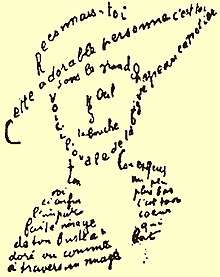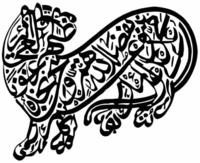Calligram

Calligram in French by Guillaume Apollinaire describing and visually representing his lover. Parts of the face's image (such as the hat, eye, nose, mouth, neck) each use words associated specifically with that part.
A calligram is a text visually arranged in a way that it forms an image associated with the text's contents. It can be a poem, a phrase, a portion of scripture, or a single word; the visual arrangement can rely on certain use of the typeface, calligraphy or handwriting, for instance along non-parallel and curved text lines, or in shaped paragraphs. The image created by the words illustrates the text by expressing visually what it says, or something closely associated; it can also, on purpose, show something contradictory with the text or otherwise misleading.
Guillaume Apollinaire was a famous calligram writer and author of a book of poems called Calligrammes.
Gallery
 Calligram of a tiger in Arabic script
Calligram of a tiger in Arabic script.svg.png) Calligram of a snake in Georgian script
Calligram of a snake in Georgian script- Calligram about the Eiffel Tower by Guillaume Apollinaire
.jpg) Biggest Calligram in the World, part of the permanent exhibition of the Valencian Museum of Ethnology.
Biggest Calligram in the World, part of the permanent exhibition of the Valencian Museum of Ethnology.- In 1834 a French court ordered the satiric newspaper Le Charivari to publish on its front page a judgement entered against it for having carried a drawing of King Louis-Philippe in the shape of a pear. The newspaper printed the document as instructed—but in the shape of a pear.
See also
References
- Sonja A.J. Neef: Kalligramme. Zur Medialität einer Schrift. Anhand von Paul van Ostaijens "De feesten van angst en pijn". Amsterdam: ASCA Press 2000
- Deme, Zoltan: Poem-miniatures. In: Chords of Scales, Globe Publish House 1995. Library of Congress No: 2003278749
- Post-War Japanese Poetry (with lots of Japanese calligrams), Penguin Books, 1972.
External links
This article is issued from
Wikipedia.
The text is licensed under Creative Commons - Attribution - Sharealike.
Additional terms may apply for the media files.